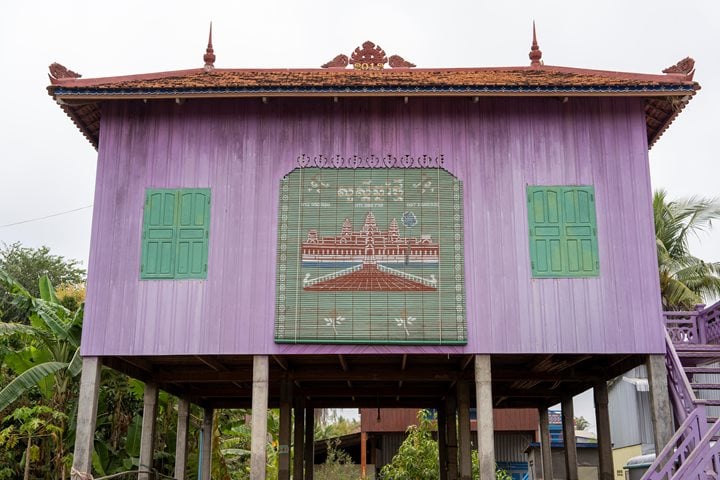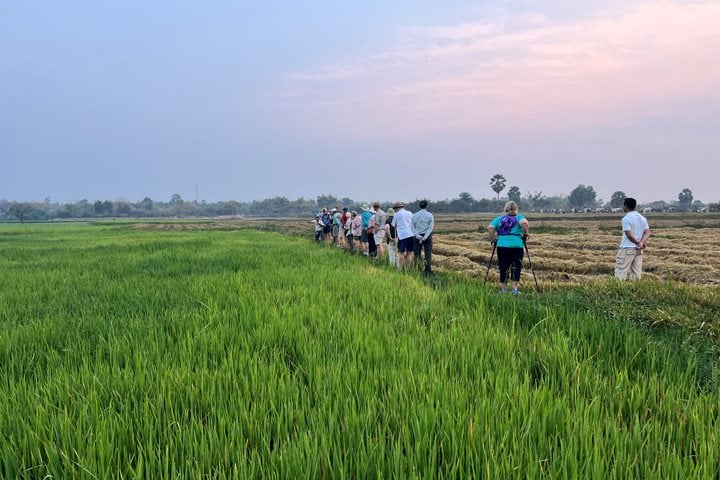Kampong Cham, Wat Nokor & Wat Hanchey, Cambodia
They make you think of egrets – thin, light, graceful, lithe, gentle… small steps, one by one, rhythmic, unhurried… a joyful harvest dance… They’re girls sponsored by a local non-profit organization helping disadvantaged youths. They were there on the sidewalk in Kampong Cham, dancing barefoot in the dust, and singing in ethereal voices full of innocence to the accompaniment of a five-piece traditional band, also comprised of youths… to welcome us as we go ashore in the early morning. They also make you think of phoenixes: they give you hope as you begin to imagine they will rise out of the ashes of Cambodia’s recent dark history, taking their generation and their nation to a more prosperous and more blissful time.
After that beginning, guests are taken on a short bus ride through this town with hints of French urban designs, past bustling blocks of shops and stalls and wide brick sidewalks, towards the past. The past is Wat Nokor, a humble yet impressive temple built of red and black laterite stone. Constructed in the 12th century, Wat Nokor is a square compound with intricate arches and walls surrounding a modern temple. A soft wind relieves us of the unforgiving heat, and creates a monotone symphony among the fig and banyan leaves above us, mixed with the echoes of chanting from a wedding nearby. In some moments, the chants are clearly Buddhist, but in some others, they take on the semblance of Islamic calls to prayers.
The ancient walls and carved forms cast a shadow on the courtyard, reaching into the French/Italian-style tiles of the walkways that surround the modern Buddhist temple. Inside, every inch of the bright blue columns and ceilings bear golden images of Buddha, and scenes of devotion and learning in a kaleidoscope of colors that bring to mind sacred paintings in the monasteries of Bhutan or Tibet. There is too a definite Hindu influence here, while outside, half-hidden in an upper corner of the laterite walls, a small cat sits in silence, motionless, an animate expression in its eyes. Zen-like, it contemplates the temple visitors below, while its own presence in this temple also bears hints of a Taoist disposition. Just outside the ancient compound, guests find another structure containing sculptures of warriors, sacred monkeys and snakes, and Buddha in lotus position. It’s all new, but these are testaments to the Cambodian insistence on the nation’s traditions and spiritual devotion.
On the way back to the Jahan, guests are given a chance to view a long bridge made of thousands of crisscrossing bamboo sticks – an astonishing engineering achievement, but also yet another symbol of what we have learned of this country and its people: gentle and delicate, fragile yet sturdy, resourceful, and often imbued with an elegant simplicity.
Following lunch, the Buddhist spirit is invited aboard with the presence of Cambodian monks who offer a half-hour chanting session, bringing blessings to the guests and staff on the Jahan.
Guests then spend the afternoon on the final excursion from the ship. The steps ashore are steep, the expectations tinged with fun: we’re to ride up a hill on the back of scooters driven by local men and women. The ride takes our guests to Wat Hanchey. It is a modern temple complex built upon the site of an ancient site, another pre-Angkorian structure of the 7th century. Guests wander about in amazement at the colors – blue and gold and bright pink pagodas underneath the green canopy of large banyan trees. Blond gibbons with black faces jump around on the branches while below villagers offer fried noodles and fruit juices. In the distance, young novice monks dot the scenery with their saffron robes.
On the tree trunks throughout the compound, there are pieces of wood painted blue, sporting proverbs and other sayings in both Khmer and English: many seem to be Buddhist teachings, others seem to be translations of popular idioms in English. “Rather Be Born Lucky than Rich.” “A Mind is a Terrible Thing to Waste.” “Honesty is the Best Policy.” One wooden plaque is apt for our last day on the Jahan and our anticipated journey toward Siem Reap to visit the marvels of the Angkor complex: “Welcome to Your Trip.”
A surreal touch is added to the entire area with giant concrete sculptures of alligators, lions, hippos, horses and buffalos, and replicas of tropical fruits, painted in all the bright colors. They’re there to help teach the young children, and they lend a semblance of a children’s amusement park. One temple is a shrine with a dozen larger-than-life cement sculptures of noted monks. You keep walking around and around to marvel at this mixture of religious devotion and playground atmosphere. At some point, the guests will wander over to one edge of the hill to be rewarded with a peaceful scene below – the Mekong, languid and gentle as it snakes its way past the sandy beaches and green pastures.
Tonight is our last on the Jahan. Another feast is prepared, and the Jahan staff members take their bows to say goodbye while we silently feel deep inside us the gratitude for their services of the past week, and for their unwavering smiles. Words of farewell are exchanged as guests take up invitations to learn a few Cambodian dance moves, not quite mastering them, but happy that for a moment, we’ve touched and been touched by their grace.






